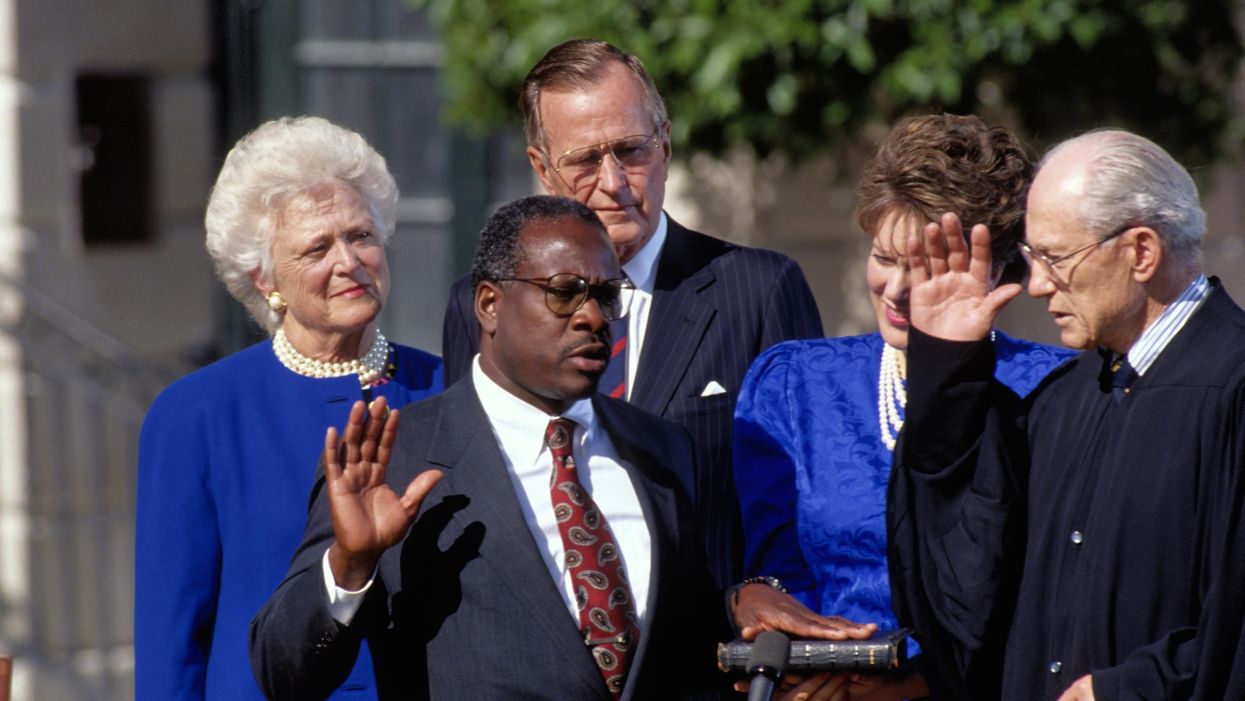Goldstone’s most recent book is "On Account of Race: The Supreme Court, White Supremacy, and the Ravaging of African American Voting Rights."
A few decades ago, some savvy operatives on the right came to understand the immense political advantages of selecting judges and Supreme Court nominees young enough to serve almost in perpetuity. The most prominent of these early post-pubescent nominees, Clarence Thomas in 1991, was also the most contentious, at least until recently. The Anita Hill storm aside, Thomas was considered neither a brilliant legal scholar nor possessed of a long history of judicial achievement. He had been a judge for only 18 months. But that was hardly the point.
And so, President George H.W. Bush, after proclaiming an exhaustive search for the best qualified man or woman to help steer the nation’s search for justice, settled on the 43-year-old Thomas, the second youngest person to be named to the court in the 20th century. That the arch-conservative Thomas, the second Black Supreme Court nominee, was to fill the seat of the first Black Supreme Court nominee, the towering Thurgood Marshall, inflamed passions on the left but Thomas survived both scandal and mediocrity to squeak by in the Senate.
That a man whose main, if not only, qualification to be chosen for the nation’s highest tribunal was his youth was due solely to the interpretation of the phrase “shall hold their offices during good behaviour” as meaning “for life.” Given that reading of Article III, Section 1 of the Constitution, the only way to replace a justice is if a majority of the House votes to indict them for a crime or other impeachable offense and two-thirds of the Senate agrees. As only one Supreme Court justice has ever been impeached — Samuel Chase in 1804 — and none convicted, removal for cause is unlikely at best. If anything, Thomas’ ability to blithely ignore the outrage surrounding his wife’s blatantly partisan shenanigans with far-right conspiracy theorists, what used to be called “the lunatic fringe,” is ample testimony that successful impeachment is a near impossibility.
With the guarantee of lengthy service came an extreme increase in the stakes — thus Republicans’ refusal to consider Merrick Garland, the beer brawl over Brett Kavanaugh in 2018, and the shoehorn confirmation of Amy Coney Barrett in 2020. In addition, by limiting appointments to men and women too young to join AARP, the nation has effectively eliminated an entire range of highly accomplished and respected jurists, lawyers and legal scholars from consideration. Marshall, who was 60 at the time of his appointment, as was Oliver Wendell Holmes, would not even make the short list today.
One of the proposals for restoring some degree of fairness to the appointment process, as well as curbing what has become the court’s virtually unchecked power, is the institution of term limits. But this approach, despite its obvious advantages in creating a more balanced court, has been considered undoable through ordinary legislation because, with lifetime tenure enshrined in Article III, any attempt to alter that arrangement would require an amendment, another unwieldy and improbable prospect.
Except that Article III actually enshrines no such thing.
It can just as easily be postulated that what the Framers had in mind was not that judges could remain on the bench until they keeled over, but rather that, as long as they discharged their duties professionally, they could not be removed solely for their political views. In addition to their failed Chase impeachment, Jeffersonians tried to pry John Pickering out of his seat as a federal District Court judge in 1803, claiming “drunkeness” when it was actually a transparent attempt to erode Federalist influence in the judiciary. Both Pickering and Chase survived because the only real charges against them were strictly political. Thomas Jefferson himself made little secret of his desire to try to remove his cousin, Chief Justice John Marshall, in favor of his friend Spencer Roane, but Marshall, as agile politically as they come, gave him no opening.
Regardless, many scholars insist that the Framers equated “good behavior” with “for life” as a generally accepted concept, and so the two phrases are interchangeable. There is, however, a good bit of evidence to indicate this was not the case.
During the debates at the Constitutional Convention in 1787, when the delegates were deciding both the manner of selecting senators and their terms of office, a proposal was made that senators serve without the need for reappointment. Gouverneur Morris, the man who wrote the final draft of the Constitution, commented that while the Senate should possess an “aristocratic spirit,” “a Senate for life” would be “noble bait” to potential demagogues who sought such an appointment as a base of power. If anyone would know the difference between “good behavior” and “life,” it was Morris.
In addition, while debating a president’s proposed term of office, Virginia’s George Mason responded to Alexander Hamilton’s suggestion that the executive “be vested with lifetime tenure or at least tenure during good behavior,” insisting that “good behavior” could be construed as “a softer name only for executive for life.” It seems that both Hamilton and Mason recognized the difference in the two terms as well. Thus, if the Framers intended judges to serve “for life,” it would have been a simple matter for Morris to draft the sentence to make that intention clear.
There is indirect evidence as well. For four long, hot months in Philadelphia in 1787, delegates who did not know and often did not like one another wrangled to try to find a means of government that would provide some centralized authority without granting any branch sufficient tools to wield despotic power over either the other branches or the states. It stretches credibility to believe that in the midst of these often acrimonious negotiations, the delegates would be willing to create one branch that consisted of unelected, lifetime members with no checks on their authority or power, short of impeachment, which was made intentionally impracticable.
If, therefore, Article III is read the way the Framers likely intended, establishing term limits for justices would not require a constitutional amendment, just an act of Congress. If such a law would pass and be signed by the president, the nation would not only return a degree of civility to a process that has careened hopelessly out of control, but we could once again begin to choose members of the nation’s highest and most powerful court on the basis of their achievements, rather than just their longevity.





















